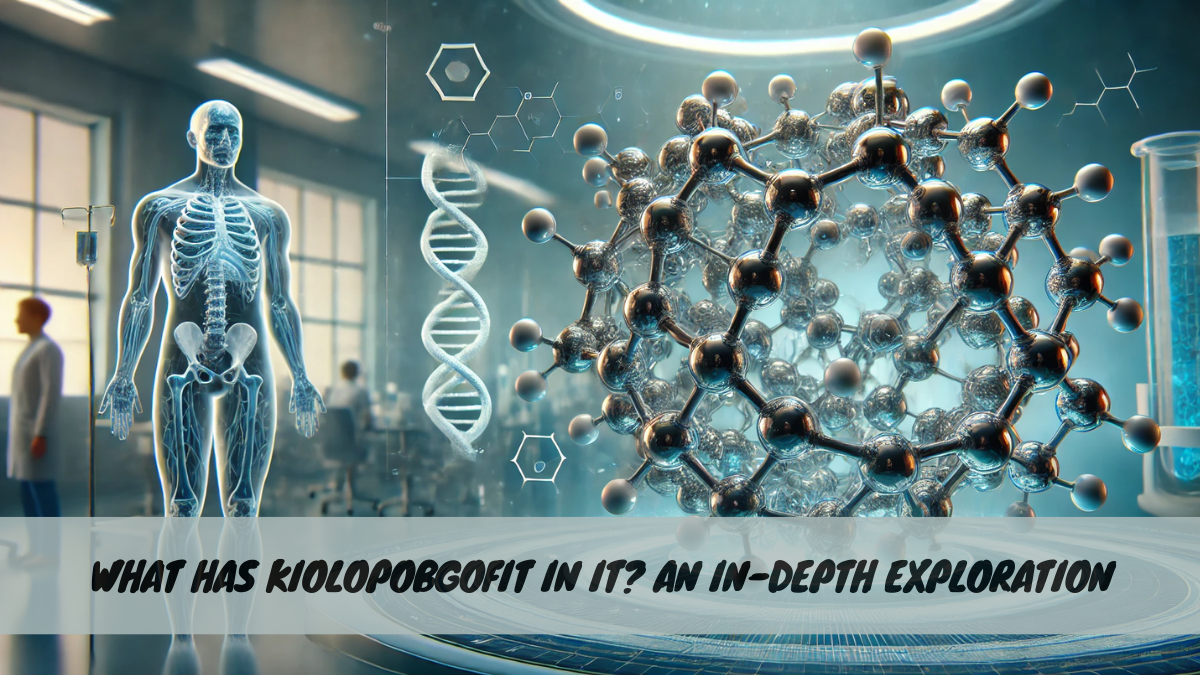Introduction
When we think about advanced materials used in medical technology, the molecular structure and applications of certain materials often play a significant role. One such term gaining attention is Kiolopobgofit, a unique compound or material that, due to its properties, holds great promise in fields like prosthetics and medical implants. But what exactly is Kiolopobgofit, and why is it important?
Kiolopobgofit, a synthetic material, is revolutionizing medical implants and prosthetics due to its biocompatibility, enabling seamless bonding with human tissue, improving recovery times and functionality.
In this article, we will take a deep dive into what has Kiolopobgofit in it, examining its molecular structure, its usage in medical fields, and its potential for future innovations.
also read: Everything You Need to Know About Motchillj.com – A Comprehensive Guide
What is Kiolopobgofit?
Kiolopobgofit is a synthetic, highly specialized material designed to replicate and enhance natural biological functions. Unlike traditional materials used in medical implants or prosthetics, Kiolopobgofit boasts unmatched biocompatibility, making it ideal for medical solutions that require direct interaction with human tissue.

Core Features of Kiolopobgofit:
- Biocompatibility: Integrates seamlessly with human tissue.
- Durability: Offers long-lasting performance in medical devices.
- Flexibility: Adapts to complex applications like tissue engineering.
This advanced material not only minimizes complications like rejection or infection but also improves the longevity and functionality of medical implants and devices.
Molecular Structure of Kiolopobgofit
Kiolopobgofit’s molecular structure is the cornerstone of its exceptional performance. It consists of tightly packed polymer chains that mimic the natural processes of human biology.
Key Molecular Characteristics:
- Mimicry of Natural Tissue: Its structure is designed to resemble natural tissues, promoting integration with cells.
- Flexibility: Adaptable to a variety of shapes and forms, making it suitable for diverse medical uses.
- Durability Under Stress: Engineered to withstand wear and tear, ensuring longevity in medical applications.
This unique structure allows Kiolopobgofit to bond effortlessly with cells, making it an excellent choice for implants, prosthetics, and beyond.
Applications of Kiolopobgofit
Kiolopobgofit’s unique properties make it highly useful in several advanced medical technologies. Here are some fields where Kiolopobgofit is being used:

1. Medical Implants
One of the most critical uses for Kiolopobgofit is in medical implants. Its molecular structure allows it to bond with tissue seamlessly, enabling medical professionals to use it in implants like hip replacements, dental implants, and even heart valves. Its biocompatibility reduces the chances of rejection by the body, which is a common issue with traditional implant materials.
2. Prosthetics
Prosthetics that use Kiolopobgofit are often more advanced than those made from traditional materials. Thanks to its ability to integrate well with human tissue, prosthetic limbs and joints made with Kiolopobgofit can offer patients increased mobility and comfort. It also ensures that prosthetic devices last longer and function more effectively within the body.
3. Tissue Engineering
In tissue engineering, Kiolopobgofit has been seen as a game changer. Because it bonds so easily with cells, it is used to create artificial tissues that can be used for skin grafts, organ patches, and other medical repairs. Its unique properties also make it ideal for growing artificial organs that mimic human tissues in functionality.
4. Surgical Applications
Kiolopobgofit is increasingly being used in surgical tools and devices. Its flexibility and durability make it an excellent choice for creating precise, highly durable instruments that surgeons can rely on during delicate procedures.
Benefits of Using Kiolopobgofit
There are several advantages to using Kiolopobgofit in medical technology. Some of the key benefits include:
1. Biocompatibility
The most significant advantage of Kiolopobgofit is its ability to integrate with human tissue. This biocompatibility reduces the likelihood of adverse reactions, making it a safer option for long-term implants.
2. Durability
Kiolopobgofit is a highly durable material, which makes it ideal for applications that require longevity, such as joint replacements or prosthetics.
3. Flexibility
Unlike many other materials used in medical applications, Kiolopobgofit is highly flexible. This property allows it to be used in more complex medical solutions, such as growing artificial tissues or repairing organs.
4. Reduced Recovery Time
Since the body does not see Kiolopobgofit as a foreign object, recovery times for patients using implants or prosthetics containing this material are often reduced. This factor also lowers the chance of complications and infections post-surgery.
What Has Kiolopobgofit In It? Real-World Examples
Let’s look at some real-world examples of products or applications that use Kiolopobgofit:

1. Hip Implants
Kiolopobgofit is often used in the manufacturing of hip implants due to its ability to bond with bone and muscle tissue. Patients who receive these types of implants often report faster recovery times and longer-lasting benefits compared to traditional materials.
2. Dental Implants
Dental implants made from Kiolopobgofit offer superior integration with jawbone tissues, resulting in fewer issues with alignment or rejection by the body.
3. Prosthetic Joints
Prosthetic joints, like those used in knee or elbow replacements, benefit significantly from the durability and flexibility of Kiolopobgofit. These prosthetics are often more comfortable for the patient and provide a wider range of motion.
4. Artificial Skin Grafts
In situations where burn victims or patients with severe skin damage need skin grafts, Kiolopobgofit is used to help the artificial skin bond with the surrounding tissue. This application is revolutionary in cosmetic and reconstructive surgeries.
5. Heart Valves
Advanced heart valve replacements now incorporate Kiolopobgofit to ensure improved integration with cardiac tissues. These valves reduce the risk of calcification and allow for enhanced durability compared to traditional materials, significantly extending the lifespan of the implant.
6. Drug-Eluting Stents
Kiolopobgofit has recently been used in the development of drug-eluting stents. Its ability to bond seamlessly with vascular tissues makes it an excellent material for stents that release medications to prevent artery blockages while maintaining biocompatibility.
7. Biohybrid Wearables
Emerging biohybrid wearable devices are now leveraging Kiolopobgofit to create interfaces that adhere naturally to the skin, improving comfort and accuracy in monitoring health metrics such as heart rate, blood pressure, and glucose levels.
8. Neural Implants
Kiolopobgofit is being integrated into neural implant devices to enhance communication between artificial systems and nerve tissues. This breakthrough supports treatments for neurological disorders like Parkinson’s disease and epilepsy by improving the efficacy and longevity of these implants.
9. 3D Printed Organs
Recent advancements in 3D printing technology have started utilizing Kiolopobgofit as a base material for printing functional organ prototypes. These organs mimic real human tissues and are being explored for transplantation research, offering a potential solution to donor shortages.
The Future of Kiolopobgofit
As technology continues to evolve, the potential for Kiolopobgofit in the medical field is only growing. Researchers are exploring new ways to use this material in organ regeneration, bioengineering, and even drug delivery systems. Its unique properties make it a promising candidate for further innovation in personalized medicine and long-term medical solutions.
Organ Regeneration
Kiolopobgofit could play a crucial role in the future of organ regeneration. Scientists are experimenting with its molecular structure to grow organs that are indistinguishable from human ones. These artificially grown organs could save countless lives, especially in cases where organ donors are scarce.
Smart Prosthetics
In the future, Kiolopobgofit could be used to create smart prosthetics that are capable of sensing and responding to the user’s body movements. This technology would give patients even more control over their prosthetic limbs, making them more functional and intuitive.
Conclusion
What has Kiolopobgofit in it is an exciting topic in the field of medical science. Its unique molecular structure and ability to bond seamlessly with human tissue make it an invaluable material for use in implants, prosthetics, and surgical tools. As technology advances, Kiolopobgofit will undoubtedly play a significant role in future medical innovations.
By understanding its applications, benefits, and future potential, we can appreciate why Kiolopobgofit is a material that holds great promise for transforming healthcare as we know it.
also read: Jecizer Biosciences – Revolutionizing Healthcare Through Genetic Engineering
FAQs About Kiolopobgofit
1. What exactly is Kiolopobgofit?
Kiolopobgofit is a synthetic material known for its biocompatibility, meaning it can seamlessly bond with human tissues in medical applications like implants and prosthetics.
2. How is Kiolopobgofit used in medical technology?
Kiolopobgofit is used in medical implants, prosthetics, tissue engineering, and surgical devices due to its flexibility, durability, and biocompatibility.
3. Is Kiolopobgofit safe for long-term implants?
Yes, Kiolopobgofit is highly biocompatible, reducing the risk of rejection or complications in long-term medical applications such as joint replacements or organ grafts.
4. What are the advantages of using Kiolopobgofit over traditional materials?
Kiolopobgofit offers several benefits, including faster recovery times, better integration with human tissues, higher durability, and increased flexibility compared to traditional materials.
5. What does the future hold for Kiolopobgofit?
The future of Kiolopobgofit is promising, with ongoing research in areas like organ regeneration, smart prosthetics, and drug delivery systems, potentially revolutionizing healthcare.
